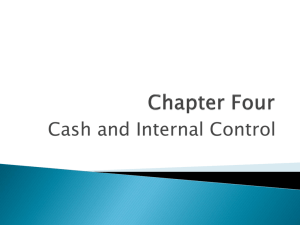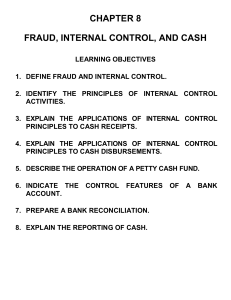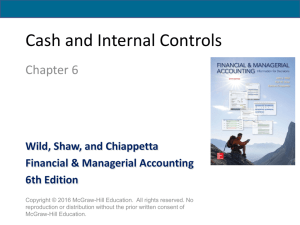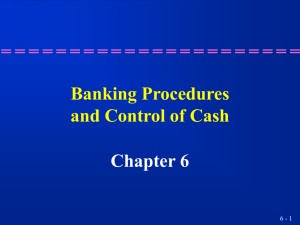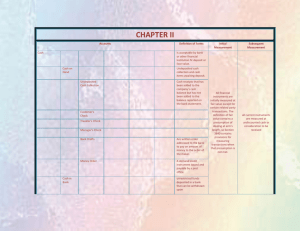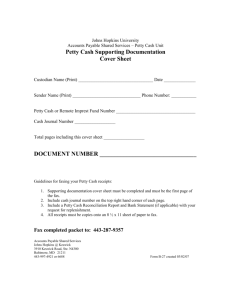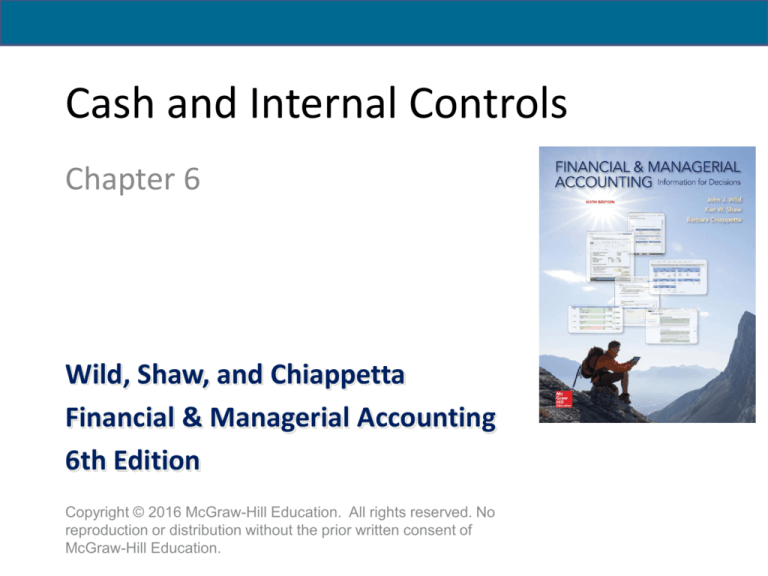
Cash and Internal Controls
Chapter 6
Wild, Shaw, and Chiappetta
Financial & Managerial Accounting
6th Edition
Copyright © 2016 McGraw-Hill Education. All rights reserved. No
reproduction or distribution without the prior written consent of
McGraw-Hill Education.
06-C1: Internal Control
2
8-3
Internal Control System
Policies and procedures managers use to:
– Protect assets.
– Ensure reliable accounting.
– Urge adherence to company policies.
– Promote efficient operations.
C1
3
8-4
Sarbanes-Oxley Act (SOX)
The Sarbanes-Oxley Act requires managers and auditors of
public companies to document and certify the system of internal
controls.
Section 404 of SOX requires that managers document and
assess the effectiveness of all internal control processes that
can impact financial reporting.
C1
4
8-5
Principles of Internal Control
Internal control principles common to all
companies:
1.
Establish responsibilities.
2.
Maintain adequate records.
3.
Insure assets and bond key employees.
4.
Separate recordkeeping from custody of assets.
5.
Divide responsibility for related transactions.
6.
Apply technological controls.
7.
Perform regular and independent reviews.
C1
5
8-6
Technology and Internal Control
Reduced
Processing
Errors
More
Extensive Testing
of Records
Limited
Evidence of
Processing
Crucial
Separation of
Duties
Increased
E-Commerce
C1
6
8-7
Limitations of Internal Control
Human Error
Human Fraud
Negligence
Fatigue
Misjudgment
Confusion
Intent to
defeat internal
controls for
personal gain
Human fraud triple-threat:
Opportunity, Pressure, and Rationalization
C1
7
8-8
Limitations of Internal Control
The costs of internal controls
must not exceed their benefits.
C1
8
NEED-TO-KNOW
Identify the following phrases/terms as best linked with the (a) purposes of an internal control system,
(b) principles of internal control, or (c) limitations of internal control.
1)
2)
3)
4)
5)
6)
7)
8)
9)
10)
11)
12)
13)
14)
C1
Protect assets
Establish responsibilities
Human error
Maintain adequate records
Apply technological controls
Ensure reliable accounting
Insure assets and bond key employees
Human fraud
Separate recordkeeping from custody of assets
Divide responsibility for related transactions
Cost-benefit principle
Promote efficient operations
Perform regular and independent reviews
Urge adherence to company policies
9
NEED-TO-KNOW
C1
1)
2)
3)
4)
5)
6)
7)
8)
9)
10)
11)
12)
13)
14)
Protect assets
Establish responsibilities
Human error
Maintain adequate records
Apply technological controls
Ensure reliable accounting
Insure assets and bond key employees
Human fraud
Separate recordkeeping from custody of assets
Divide responsibility for related transactions
Cost-benefit principle
Promote efficient operations
Perform regular and independent reviews
Urge adherence to company policies
a)
Purposes of internal controls
Protect assets.
Promote efficient operations.
Ensure reliable accounting.
Urge adherence to company policies.
a) Purpose of internal controls
a) Purpose of internal controls
a) Purpose of internal controls
a) Purpose of internal controls
10
NEED-TO-KNOW
C1
1)
2)
3)
4)
5)
6)
7)
8)
9)
10)
11)
12)
13)
14)
Protect assets
Establish responsibilities
Human error
Maintain adequate records
Apply technological controls
Ensure reliable accounting
Insure assets and bond key employees
Human fraud
Separate recordkeeping from custody of assets
Divide responsibility for related transactions
Cost-benefit principle
Promote efficient operations
Perform regular and independent reviews
Urge adherence to company policies
a) Purpose of internal controls
b) Principles of internal controls
a)
Purposes of internal controls
Protect assets.
Promote efficient operations.
Ensure reliable accounting.
Urge adherence to company policies.
b)
Principles of internal controls
Establish responsibilities.
Maintain adequate records.
Insure assets and bond key employees.
Separate recordkeeping from custody of assets.
Divide responsibility for related transactions.
Apply technological controls.
Perform regular and independent reviews.
b)
b)
a)
b)
Principles of internal controls
Principles of internal controls
Purpose of internal controls
Principles of internal controls
b) Principles of internal controls
b) Principles of internal controls
a) Purpose of internal controls
b) Principles of internal controls
a) Purpose of internal controls
11
NEED-TO-KNOW
C1
1)
2)
3)
4)
5)
6)
7)
8)
9)
10)
11)
12)
13)
14)
Protect assets
Establish responsibilities
Human error
Maintain adequate records
Apply technological controls
Ensure reliable accounting
Insure assets and bond key employees
Human fraud
Separate recordkeeping from custody of assets
Divide responsibility for related transactions
Cost-benefit principle
Promote efficient operations
Perform regular and independent reviews
Urge adherence to company policies
a) Purpose of internal controls
b) Principles of internal controls
c) Limitations of internal controls
b) Principles of internal controls
b) Principles of internal controls
a) Purpose of internal controls
b) Principles of internal controls
c) Limitations of internal controls
b) Principles of internal controls
b) Principles of internal controls
c) Limitations of internal controls
a) Purpose of internal controls
b) Principles of internal controls
a) Purpose of internal controls
a)
Purposes of internal controls
Protect assets.
Promote efficient operations.
Ensure reliable accounting.
Urge adherence to company policies.
c) Limitations of internal controls
Human elements include:
Human error.
Human fraud.
Cost-benefit principle.
b)
Principles of internal controls
Establish responsibilities.
Maintain adequate records.
Insure assets and bond key employees.
Separate recordkeeping from custody of assets.
Divide responsibility for related transactions.
Apply technological controls.
Perform regular and independent reviews.
12
06-C2: Cash, Cash Equivalents,
and Liquidity
13
8 - 14
Control of Cash
An effective system of internal control that
protects cash and cash equivalents should meet
three basic guidelines:
Handling cash
is separated from
recordkeeping for
cash.
C2
Cash receipts
are promptly
deposited in a
bank.
Cash
disbursements
are made by
check.
14
8 - 15
Cash, Cash Equivalents,
and Liquidity
Cash and similar assets are called liquid assets because they can
be readily used to settle such obligations.
Cash
Currency, coins, and amounts on deposit in bank accounts,
checking accounts, and some savings accounts. Also
includes items such as customer checks, cashier checks,
certified checks, and money orders.
C2
Cash Equivalents
Short-term, highly liquid investments that are:
1. Readily convertible to a known cash
amount.
2. Close to maturity date and not sensitive
to interest rate changes.
15
8 - 16
Cash Management
The goals of cash management are twofold:
1.
Plan cash receipts to meet cash payments when due.
2.
Keep a minimum level of cash necessary to operate.
Effective cash management involves applying
the following cash management principles:
Encourage collection of receivables.
Delay payment of liabilities.
Keep only necessary levels of assets.
Plan expenditures.
Invest excess cash.
C2
16
06-P1: Control of Cash
Receipts
17
8 - 18
Over-the-Counter Cash Receipts
This graphic illustrates that none of the people
involved can make a mistake or divert cash
without the difference being revealed.
P1
18
8 - 19
Cash Over and Short
Sometimes errors in making change are discovered from
differences between the cash in the cash register and the
record of the amount of cash receipts.
If a cash register’s record shows $550 but the count of cash in
the register is $555, we would prepare the following journal
entry:
P1
19
8 - 20
Cash Over and Short
Sometimes errors in making change are discovered from
differences between the cash in the cash register and the
record of the amount of cash receipts.
On the other hand, if a cash register’s record shows $625 but
the count of cash in the register is
$621, the entry to record cash sales and its shortage is:
P1
20
8 - 21
Cash Receipts by Mail
Preferably, two
people are
assigned the
task of opening
the mail.
P1
The cashier
deposits the
money in a
bank.
The
recordkeeper
records the
amounts
received in the
accounting
records.
21
8 - 22
Control of Cash Disbursements
Control of cash disbursements is
especially important as most large
thefts occur from payment of
fictitious invoices.
Keys to Controlling Cash Disbursements
• Require all expenditures to be made by check.
• Limit access to checks except for those who
have the authority to sign checks.
P1
22
8 - 23
Voucher System of Control
A voucher system establishes procedures for:
1. Verifying, approving, and recording
obligations for eventual cash disbursements.
2. Issuing checks for payment of verified,
approved, and recorded obligations.
P1
23
8 - 24
Voucher System of Control
P1
24
NEED-TO-KNOW
A good system of internal control for cash provides adequate procedures for protecting both cash receipts
and cash disbursements. Which of the following statements are true regarding the control of cash receipts
and disbursements?
1. Over-the-counter cash receipts from sales should be recorded on a cash register at the time of
each sale. True – All sales should be recorded on a cash register.
2. Custody over cash should be separate from the recordkeeping of cash. True – Segregation of duties
3. For control of cash receipts that arrive through the mail, two people should be assigned the task
of, and be present for, opening that mail. True – Segregation of duties
4. One key to controlling cash disbursements is to require that no expenditures be made by check;
instead, all expenditures should be made from petty cash. False – Only small amounts should be paid
from petty cash.
5. A voucher system of control should be applied only to purchases of inventory and never to other
expenditures. False – A voucher system should be applied to all purchases.
P1
25
06-P2: Control of Cash
Disbursements
26
8 - 27
Petty Cash System of Control
Small payments required in most companies
for items such as postage, courier fees,
repairs, and supplies.
P2
27
8 - 28
Operating a Petty Cash Fund
P2
28
8 - 29
Operating a Petty Cash Fund
P2
29
8 - 30
Operating a Petty Cash Fund
P2
30
NEED-TO-KNOW
Bacardi Company established a $150 petty cash fund with Eminem as the petty cashier. When the fund
balance reached $19 cash, Eminem prepared a petty cash payment report, which follows.
Receipt No.
12
13
15
16
Account Charged
Delivery Expense
Merchandise Inventory
(Omitted)
Miscellaneous Expense
Total
$29
18
32
41
$120
Approved by
Eminem
Eminem
Eminem
(Omitted)
Received by
A. Smirnoff
J. Daniels
C. Carlsberg
J. Walker
Required:
1. Identify four internal control weaknesses from the payment report.
Petty cash ticket no. 14 is missing. All petty cash tickets should be pre-numbered and all
numbers should be accounted for.
Since total cash on hand is only $19, $131 has been withdrawn ($150 - $19). Only $120 in
expenditures has been documented. Management should investigate the $11 cash shortage.
The petty cashier did not sign petty cash receipt no. 16. Was the expense approved, or was this
an oversight?
Petty cash receipt no. 15 does not indicate the account to be charged. If possible, management
should determine the correct account; if impossible, Miscellaneous Expense should be charged.
P2
31
NEED-TO-KNOW
Bacardi Company established a $150 petty cash fund with Eminem as the petty cashier. When the fund
balance reached $19 cash, Eminem prepared a petty cash payment report, which follows.
Receipt No.
12
13
15
16
Account Charged
Delivery Expense
Merchandise Inventory
(Omitted)
Miscellaneous Expense
Total
$29
18
32
41
$120
Approved by
Eminem
Eminem
Eminem
(Omitted)
Received by
A. Smirnoff
J. Daniels
C. Carlsberg
J. Walker
2. Prepare general journal entries to record the establishment of the fund and the
reimbursement of the fund. (Assume that management was unable to verify the account
number for receipt no. 15.)
Date
Establish
General Journal
Petty cash
Cash
Reimburse Delivery expense
Merchandise inventory
Miscellaneous expense
Cash short and over
Cash ($150 - $19)
P2
Debit
150
Credit
150
29
18
73
11
131
32
NEED-TO-KNOW
Bacardi Company established a $150 petty cash fund with Eminem as the petty cashier. When the fund
balance reached $19 cash, Eminem prepared a petty cash payment report, which follows.
Receipt No.
12
13
15
16
Account Charged
Delivery Expense
Merchandise Inventory
(Omitted)
Miscellaneous Expense
Total
$29
18
32
41
$120
Approved by
Eminem
Eminem
Eminem
(Omitted)
Received by
A. Smirnoff
J. Daniels
C. Carlsberg
J. Walker
3. What is the Petty Cash account balance immediately before reimbursement? $150
Immediately after reimbursement? $150
The balance in Petty cash remains constant unless the amount of the fund is changed.
P2
33
8 - 34
Basic Bank Services
Signature Cards
Deposit Tickets
Bank Accounts
Bank
Statements
Checks
Electronic
Funds Transfer
P2
34
8 - 35
Bank Statement
Usually once a
month, the
bank sends
each depositor
a bank
statement
showing the
activity in the
account.
P2
35
06-P3: Bank Reconciliation
36
8 - 37
Bank Reconciliation
A bank reconciliation is prepared periodically to explain
the difference between cash reported on the bank
statement and the cash balance on company’s books.
P3
37
8 - 38
Bank Reconciliation
The balance of a checking account reported on the bank statement rarely
equals the balance in the depositor’s accounting records.
Cash Balance per Bank
Cash Balance per Book
+ Deposits in Transit
+ Collections & Interest
- Outstanding Checks
- Uncollectible items
+/- Errors
+/- Errors
Adjusted Cash Balance
=
Adjusted Cash Balance
Adjusting entries are recorded for the reconciling items on the book side
of the reconciliation.
P3
38
8 - 39
Bank Reconciliation
We follow nine steps in preparing the
bank reconciliation.
Cash Balance per Bank
+ Deposits in Transit
- Outstanding Checks
+/- Errors
Adjusted Cash Balance
P3
39
8 - 40
Bank Reconciliation
We follow nine steps in preparing the
bank reconciliation.
Cash Balance per Book
+ Collections & Interest
- Uncollectible items
+/- Errors
Adjusted Cash Balance
P3
40
8 - 41
Bank Reconciliation
We follow nine steps in preparing the bank
reconciliation.
Adjusting entries are recorded for the reconciling items on the
book side of the reconciliation.
P3
41
8 - 42
Bank Reconciliation
Only the items reconciling the book balance
require adjustment.
P3
42
NEED-TO-KNOW
The following information is available to reconcile Gucci’s book balance of cash with its bank statement
cash balance as of December 31. Prepare the bank reconciliation for this company as of December 31.
a. The December 31 cash balance according to the accounting records is $1,610, and the bank statement
cash balance for that date is $1,900.
b. Gucci’s December 31 daily cash receipts of $800 were placed in the bank’s night depository on
December 31, but do not appear on the December 31 bank statement.
c. Check No. 6273 for $400 and Check No. 6282 for $100, both written and entered in the accounting
records in December, are not among the canceled checks. Two checks, No. 6231 for $2,000 and No.
6242 for $200, were outstanding on the most recent November 30 reconciliation. Check No. 6231 is
listed with the December canceled checks, but Check No. 6242 is not.
d. When the December checks are compared with entries in the accounting records, it is found that Check
No. 6267 had been correctly drawn for $340 to pay for office supplies but was erroneously entered in
the accounting records as $430.
e. A credit memorandum indicates that the bank collected $500 cash on a note receivable for the
company, deducted a $30 collection fee, and credited the balance to the company’s Cash account.
Gucci had not recorded this transaction before receiving the statement.
f. Two debit memoranda are enclosed with the statement and are unrecorded at the time of the reconciliation.
One debit memorandum is for $150 and dealt with an NSF check for $140 received from a customer,
Prada Inc., in payment of its account. The bank assessed a $10 fee for processing it. The second
debit memorandum is a $20 charge for check printing. Gucci had not recorded these transactions
before receiving the statement.
P3
43
NEED-TO-KNOW
Bank statement balance
Gucci
Bank Reconciliation
December 31
Book balance
Add: Items already added to the book
balance that have not yet been added to
the bank balance.
Add: Items already added to the bank
balance that have not yet been added to
the book balance.
Deduct: Items already subtracted from
the book balance that have not yet been
subtracted from the bank balance.
Deduct: Items already subtracted from
the bank balance that have not yet been
subtracted from the book balance.
Adjusted bank balance
Adjusted book balance
In the case of an error, whichever party
made the error (book or bank) will show
the correction as an adjustment.
P3
44
NEED-TO-KNOW
Gucci
Bank Reconciliation
December 31
$1,900 Book balance
Add:
800
Bank statement balance
Add:
Deposit of December 31
Deduct:
Checks No.
6273
6282
6242
Adjusted bank balance
$400
100
200
$1,610
Deduct:
Adjusted book balance
a. The December 31 cash balance according to the accounting records is $1,610, and the bank statement
cash balance for that date is $1,900.
b. Gucci’s December 31 daily cash receipts of $800 were placed in the bank’s night depository on
December 31, but do not appear on the December 31 bank statement.
c. Check No. 6273 for $400 and Check No. 6282 for $100, both written and entered in the accounting
records in December, are not among the canceled checks. Two checks, No. 6231 for $2,000 and No.
6242 for $200, were outstanding on the most recent November 30 reconciliation. Check No. 6231 is
listed with the December canceled checks, but Check No. 6242 is not.
P3
45
NEED-TO-KNOW
Gucci
Bank Reconciliation
December 31
$1,900 Book balance
Add:
800
Error (Ck 6267)
$90
2,700
Proceeds of note less $30 fee 470
Bank statement balance
Add:
Deposit of December 31
Deduct:
Checks No.
6273
6282
6242
Adjusted bank balance
$400
100
200
700
$2,000
Deduct:
NSF check
Printing fee
Adjusted book balance
$150
20
$1,610
560
2,170
170
$2,000
d. When the December checks are compared with entries in the accounting records, it is found that Check
No. 6267 had been correctly drawn for $340 to pay for office supplies but was erroneously entered in
the accounting records as $430.
e. A credit memorandum indicates that the bank collected $500 cash on a note receivable for the
company, deducted a $30 collection fee, and credited the balance to the company’s Cash account.
Gucci had not recorded this transaction before receiving the statement.
f. Two debit memoranda are enclosed with the statement and are unrecorded at the time of the reconciliation.
One debit memorandum is for $150 and dealt with an NSF check for $140 received from a customer,
Prada Inc., in payment of its account. The bank assessed a $10 fee for processing it. The second
debit memorandum is a $20 charge for check printing. Gucci had not recorded these transactions
before receiving the statement.
P3
46
NEED-TO-KNOW
Gucci
Bank Reconciliation
December 31
$1,900 Book balance
Add:
800
Error (Ck 6267)
$90
2,700
Proceeds of note less $30 fee 470
Bank statement balance
Add:
Deposit of December 31
Deduct:
Checks No.
6273
6282
6242
Adjusted bank balance
Date
Dec. 31
Dec. 31
Dec. 31
Dec. 31
P3
$400
100
200
700
$2,000
Deduct:
NSF check
Printing fee
Adjusted book balance
General Journal
Cash
Office supplies
560
2,170
$150
20
Debit
90
170
$2,000
Credit
90
Cash
Collection expense
Notes receivable
470
30
Accounts receivable - Prada Inc.
Cash
150
Miscellaneous expenses
Cash
$1,610
500
150
20
20
47
8 - 48
Global View
Internal Control Purposes, Principles, and Procedures
The purposes and principles of internal control systems are
fundamentally the same across the globe.
Control of Cash
Accounting definitions for cash are similar for U.S. GAAP and
IFRS.
Banking Activities as Controls
There is a global demand for banking services, bank statements,
and bank reconciliations. To the extent feasible, companies utilize
banking services as part of their effective control procedures.
48
06-A1: Days’ Sales
Uncollected
49
8 - 50
Days’ Sales Uncollected
Indicates how much time is likely to pass before
we receive cash receipts from credit sales.
Days’
=
sales
uncollected
A1
Accounts receivable
Net sales
× 365
50
06-P4: Documentation and
Verification
51
8 - 52
Appendix 6A:
Documentation and Verification
Purchase Requisition
Purchase Order
Invoice
Receiving Report
P4
52
06-P5: Control of Purchase
Discounts
53
8 - 54
Appendix 6B:
Control of Purchase Discounts
The net method gives management an advantage in
controlling and monitoring cash payments involving
purchase discounts.
When purchases are
recorded at net amounts,
a Discounts Lost expense
account is recorded and
brought to management’s
attention.
P5
54
8 - 55
End of Chapter 6
55


